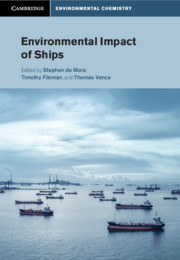Book contents
- Environmental Impact of Ships
- Cambridge Environmental Chemistry Series
- Environmental Impact of Ships
- Copyright page
- Contents
- Contributors
- Preface
- 1 Shipping, Ships and the Environment
- 2 Atmospheric Emissions from Ships
- 3 Oil Pollution from Operations and Shipwrecks
- 4 Waste and Sewage
- 5 Ballast Water
- 6 Biocides from Marine Coatings
- 7 Invasive Species
- 8 Physical Effects of Ships on the Environment
- 9 Ship Noise
- 10 Vessel Strikes and North Atlantic Right Whales
- 11 Nuclear-Powered Vessels
- 12 Environmental Impacts of Shipbreaking
- 13 International Legislative Framework
- 14 Shipping Industry’s Perspective
- 15 Environmental Impacts of Shipping
- Index
- References
12 - Environmental Impacts of Shipbreaking
Published online by Cambridge University Press: 22 January 2021
- Environmental Impact of Ships
- Cambridge Environmental Chemistry Series
- Environmental Impact of Ships
- Copyright page
- Contents
- Contributors
- Preface
- 1 Shipping, Ships and the Environment
- 2 Atmospheric Emissions from Ships
- 3 Oil Pollution from Operations and Shipwrecks
- 4 Waste and Sewage
- 5 Ballast Water
- 6 Biocides from Marine Coatings
- 7 Invasive Species
- 8 Physical Effects of Ships on the Environment
- 9 Ship Noise
- 10 Vessel Strikes and North Atlantic Right Whales
- 11 Nuclear-Powered Vessels
- 12 Environmental Impacts of Shipbreaking
- 13 International Legislative Framework
- 14 Shipping Industry’s Perspective
- 15 Environmental Impacts of Shipping
- Index
- References
Summary
Ships are mobile structures of comprehensive size and at the end of their active life (20 - 30 years of operation), they become a sought-after source of steel. In recent years, over 1000 ships were dismantled worldwide. Shipping companies sell old ships in return for a last profit: about 90% of a ship’s structure is made of steel which is recovered during the demolition process and provides several millions USD of profit for the owner – the amount depending on the size and type of vessel. Obsolete vessels available for scrapping may also represent a useful source of supply for second hand equipment and components. The very nature of vessels represents risks both to the environment, as well as to general safety aspects in the dismantling context. The considerable dimensions, their mobility and the presence of materials and polluting substances, both those integrated in the structure as well as those required for operation, are all factors contributing to such risks. There are at present no international regulatory standards relating to shipbreaking. As a result of this inconsistency, practices and procedures for decommissioning and dismantling, which are in grave breach of basic environmental and human health protection norms, have been adopted in many countries.
- Type
- Chapter
- Information
- Environmental Impact of Ships , pp. 303 - 328Publisher: Cambridge University PressPrint publication year: 2020
References
- 1
- Cited by



